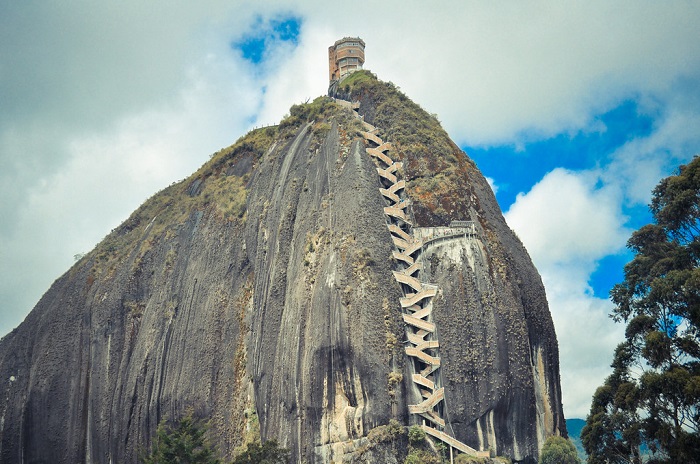ISABEL RUBIO ARROYO | Tungsteno
A rock that seems to touch the sky. This is the Stone of Peñol, also known as El Peñol or the Rock of Guatapé, one of Colombia's main tourist attractions. This 220-metre high monolith has more than 700 steps leading to the top. Its shape is the result of wind and water erosion and there are several myths and stories about it, such as that it came from outer space or is the result of a volcano.
The 'jump' to the top of the rock
This enormous granite rock, composed of quartz, feldspar and mica, is located in the municipality of Guatapé, in the department of Antioquia. The first person to climb to its summit was Luis Eduardo Villegas López on 16 July 1954. "A mad priest called Alfonso Montoya, in the middle of the 40-hour sermons during the patron saint's festivities, urged the people of Guatapé to climb it once and for all," says Álvaro Idárraga Alzate, a retired teacher from Guatapé who studies the monolith.
He says the people of Guatapé were like toads: "They stared at the stones and were afraid to jump, knowing that up there they would find the image of a saint, a miracle and gold. He told them some stories. Then this man (Villegas) climbed the stone. Then he bought a small piece of land in front of it, and after that he bought the other farms around it, one after the other," says Idárraga.
The Stone of El Peñol is one of the largest rocks on the planet. Credit: Slowly Anywhere
A rock that came from outer space?
From the ground up, the rock is 220 metres high, but according to Idárraga, its depth, reaches 2,500 metres below the surface: "It's like a pin that's just showing its little head." There are many myths about the origin of the stone. Some claim that the monolith came from outer space, while others say that the cracks on its surface are the marks left by the devil's axe. "The stone is not a meteorite, nor a piece of krypton, nor a celestial body," says Idárraga.
María Isabel Mejía Cerón, a geologist and university professor, explained to the Colombian newspaper El Espectador that some of the largest rocks in Antioquia are the result of tectonic, orogenic and magmatic movements that took place between 90 and 70 million years ago. In fact, she says that El Peñol is a volcanic rock that did not rise above the Earth's crust. Some geologists think it is likely that the rock is an outcrop that came to the surface after millions of years on the tectonic plate of the Antioquia Batholith and through the erosion of soils.
The Stone of El Peñol offers one of the most attractive views in Colombia. Credit: Babak Fakhamzadeh / Flickr
From a ritual site to a tourist attraction
In pre-Hispanic indigenous times, this monolith was the centre of rituals, according to several Colombian media citing the Historical Museum of El Peñol. El Espectador indicates that, according to some archaeological studies, the areas around El Peñol may have been used as a rubbish dump by the indigenous people. Over the centuries, the land was fertilised and cultivated. Later, Empresas Públicas de Medellín built a huge reservoir on the surrounding land to generate electricity, which boosted tourism but also forced the migration of many inhabitants of the municipalities of El Peñol and Guatapé.
In the mid-20th century, some of the locals considered the stone a nuisance, as they had to travel around it to tend to their crops. Little did they know that this gigantic granite monolith would eventually become an iconic tourist attraction. To reach its summit, Luis Eduardo Villegas built a handmade wooden staircase, which was later replaced by concrete.
For centuries, this monolith has left many generations speechless. "Looking at this rock of such enormous dimensions, in this place, the observer cannot help but wonder in amazement: What effort of nature would have been necessary to remove this enormous mass of sedimentary rock from its site and place it here, whose vertical strata indicate its formation and the portentous cataclysm to which the monolith owes its position?" wrote José María Gutiérrez de Alba in a manuscript in 1875. Thousands of tourists have come to contemplate it and capture from its summit some of the most attractive postcard images of Colombia.
Tungsteno is a journalism laboratory to scan the essence of innovation.
